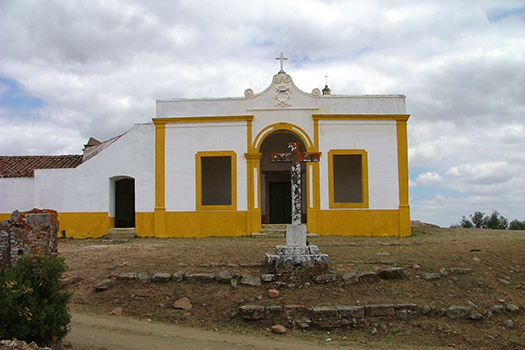 |
Until now, the oldest records that have emerged, referring the old hermitage still with Nossa Senhora da Graça (Our Lady of Grace) as Patron Saint are from 1455, the year when Pope Callixtus III granted a hundred days of forgiveness to the faithful who would give alms to the repairing of the building, as long as confessed and communed. This small allusion allows us to comprehend the antiquity of the building that was here, since it already needed repairing works in the 15th century. In 1541 the authorities of the village of Alcáçovas, through a petition to Portuguese King João III, wished for this monarch to donate the old hermitage to the Dominican Order, instead of giving it to the Order of Saint Francis, which around this time would also have been interested in getting hold of this location. Shortly after and through a Charter of Donation of 20th September 1541, the king João III offered the old hermitage to the Dominicans. Afterwards many were the donations made to the men of religion, who according to some records were never a community bigger than 12 individuals. An example of this were the donations from 1542 by D. Fernando Henriques, 3º Lord of the village of Alcáçovas, who on 13th January of that same year offered the religious men all the wine from Vale d’Alcácer’s vineyard, but only while this Lord would live; afterwards all production of that vineyard would go to his heirs. He also offered all his share of wine of the commendatory abbot of São Salvador’s vineyard.
The Saint Patronage of Nossa Senhora da Esperança (Our Lady of Hope)might have started in 1556, when Father Fray José Bezerra, one of the nine Castilians who were invited to restore the Dominican province of Portugal, stopped in that ancient hermitage. He brought only half body of a sculpture, as was described in that time by the older Dominicans, and there it was restored, becoming a sculpture of 6 spans high, inserted then on the main altar. The image was described as if it was always happy and laughing to all who looked at her. These aspects and particularities represented by the sculpture caught the attention and curiosity of all who passed by this place. The fact that this image, with the passing of time, is always in bright colours might have awoken sometimes mistrust among the faithful, who even accused the religious men of constantly painting the image. What is true is that the devotion to Nossa Senhora da Esperança evolved more and more, having the religious men many times declared that no one visited the Lady of Hope without coming back one second time.
The biggest part of the reconstruction of the building most probably took place between 1660 and 1721. We highlight the taking down of the old main chapel and subsidence of the floor in 1661 for the construction of the new altar, at a higher level than the central nave, having this work cost 400$000 portuguese réis. Later in 1664 Father Fray Manuel Correia ordered the beginning of the construction of the bell tower, which served as pillar to the new main altar. In 1684 Father Fray Francisco de Santo António had all the main altar dressed with tiles and underlay the church floor, the sacristy and main altar with adobes. All of this works were done mostly thanks to alms from the faithful, coming to this place each time more of them, not only from Alcáçovas but from all neighbor localities. Eastern, Palm Sundays, Pentecost and Christmas were the most crowded days. For instance the pilgrims from Torrão came to visit the Lady of Hope on the day of the Lord’s Annunciation (25th March). In the middle of the 17th century the most crowded day was the day of Saint Bartholomew (24th August), when a fair took place in the convent’s churchyard.
The Dominican Order most probably left the Convent of Nossa Senhora da Esperança still in the 18th century, in 1776, many years before the extinction of the Religious Orders in Portugal. This brought the formation, by some devotes of Our Lady of Hope, of a commission to administrate all the assets belonging to Our Lady of Hope, such as alms, church furniture and animals. However this dedication would end up dissolving in time.
We cannot comprehend the evolution of the Convent of Nossa Senhora da Esperança without understanding the standing importance that the pilgrim cult had in the development of the space, in the cultural and the social branches. It is easy to understand that it were the pilgrims and devotes of Our Lady of Hope to assure, at least from the 15th century to the 19th, with their alms, the necessary keeping and preservations so that the building could have arrived to our days with the particularities that only those who visit it can comprehend. It was a place continuously lived either by the people of Alcáçovas and the people of neighbor localities, who in a period between the beginnings of April and October had their own days to visit Our Lady of Hope in Alcáçovas.

 Abrir Lista
Abrir Lista MUNICÍPIO DE VIANA DO ALENTEJO
MUNICÍPIO DE VIANA DO ALENTEJO